|
 Gliophorus sulfureus Gliophorus sulfureus
SynonymsGliophorus bichromus
Hygrophorus nitidus
Omphalina sulfurea
Hygrocybe sulfurea
BiostatusPresent in region - Indigenous. Endemic
Images (click to enlarge)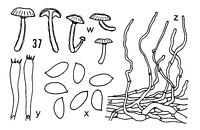
Caption: Gliophorus bichromus Hk. (type) w. carpophores. - x. spores. - y. basidia. - z. cuticle | 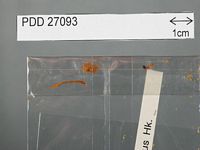
Caption: Dried type specimen
Owner: Herb PDD | 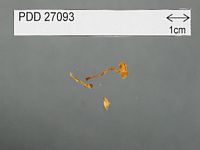
Caption: Dried type specimen
Owner: Herb PDD | 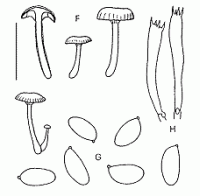
Caption: Fig. 31 Gliophorus sulfureus (Stev.) Horak.(F-H: PDD 27093, type
of G. bichromus Horak. syn.): F. basidiomes. G. spores. H. basidia. | 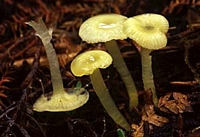
Caption: Gliophorus sulphureus
Owner: Kaimai Bush | 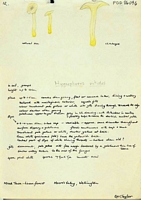
Caption: Watercolour
Owner: G.M. Taylor | 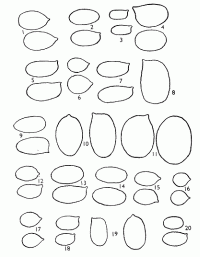
Caption: Spores X 2000 1. Hygrophorus salmonipes 2; H. elsae; 3, H .julietae; 4, H. variabilis; 5, H. lilaceo-lamelllatus; 6, H. muritaiensis; 7, H. keithgeorgei; 8, H. pseudococcineus; 9, H. rubro-carnosus; 10, H. miniceps; 11, H. procerus; 12, H. multic | 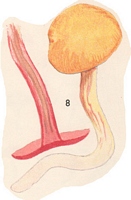 | 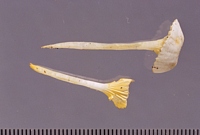
Owner: Herb. PDD | 
Caption: Fig. 20 |
Article: Horak, E. (1973). Fungi Agaricini Novazelandiae I-V. Beihefte zur Nova Hedwigia 43: 200 p.
Description: Pileus 5-l5 mm diam., hemispherical or convex becoming plano-convex or subumbilicate, egg yellow to lemon yellow fading to yellowish-grey, darker at the centre, glutinous, translucidly striated, membranaceous. Lamellae arcuate, whitish-yellowish, gill edge concolorous and even, glutinous thread absent. Stipe 10-20 x 1-2 mm, cylindric, equal but often subbulbous at the base, apex whitish, yellow at the base, glutinous, single or in clusters, solid. Context yellow. Taste and odor not distinctive. Chemical reactions on pileus: KOH- negative.
Spores 5.5-7.5 x 3-3.5 µm, ellipsoid, smooth, inamyloid. Basidia 28-32 x 4-5 µm, 4-spored. Cystidia absent. Cuticle a trichodermium of suberect, strongly gelatinized, hyaline, cylindric hyphae (2-5 µm diam.). Clamp connections numerous.
Habitat: In soil under Nothofagus cliffortioides (montane forest). New Zealand.
Notes: There is little possibility that G. bichromus could be confused with any of the other yellow coloured Gliophorus species in New Zealand if the microscopic characters are studied.
Concerning G. nitidus Berk. & Curt. ss. Stev. no material was seen but it appears that this collection refers to G. bichromus Hk. Undoubtedly these two fungi are closely related but differ mainly in the different size of the spores and basidia (Hesler & Smith 1963: 232).
From the point of view of size and colour of the carpophores Mycena primulina Stev. (1964) is very much similar to G. bichromus Hk. but differs in its conspicuous cheilocystidia and size of spores.
Article: Stevenson, G. (1963) [1962]. The Agaricales of New Zealand: IV. Kew Bulletin 16(3): 373–384.
Description: The full description given by Smith & Hesler (1942,
P.70) clearly covers the New Zealand collections, which are of small glutinous,
lemon-yellow toadstools, 1-2 cm. diam., which fade to white; spores 4-5 X 6-7
µm.
Habitat: habitat: amongst litter under forest, Keith George Park, Wellington,
15.6.1949, Butterfly, 2.6.1958, both Stevenson.
Article: Stevenson, G. (1964). The Agaricales of New Zealand: V. Kew Bulletin 19(1): 1-59.
Description: Pileus 0.4-1.4 cm diam., sulphur-yellow, darker and greyed at centre, hemispherical, matt; flesh sulphur-yellow, continuous with that of stipe. Gills decurrent, moderately distant, sulphur-yellow. Stipe 1-4 cm x 0.5-1 mm, sulphur-yellow, fragile, smooth, translucent or opaque, solid, some with white mycelium at base. Spores 6-7 x 3.5-4 µm non-amyloid, hyaline, thin-walled (Fig. 20).
Habitat: Amongst litter under shrubs and trees, Wellington, Botanic Garden, 12.8.1949, Stevenson (type).
Article: Horak, E. (1971). A contribution towards the revision of the Agaricales (Fungi) from New Zealand. New Zealand Journal of Botany 9(3): 403-462 (http://www.rsnz.org/publish/abstracts.php).
Notes: Omphalina sulphurea Stevenson (29 D) = aff. Hygrophorus sp.
Article: Horak, E. (1990). Monograph of the New Zealand Hygrophoraceae (Agaricales). New Zealand Journal of Botany 28(3): 255-306 (http://www.rsnz.org/publish/abstracts.php).
Description: Pileus-15 mm, hemispherical or convex later planoconvex or subdepressed at
centre; yolk-yellow to lemon-yellow fading to pale yellow with grey tinge; glutinous,
translucently striate at margin, membranaceous. - Lamellae 12-14 (I -3) decurrent
to arcuate; pale yellow, edges concolorous, entire glutinous thread absent.
- Stipe 10-30 x 1-2 mm cylindrical, equal or sub-bulbous at base; apex whitish,
yellow at base; glutinous, solid, single or caespitose. - Context yellow, waxy.
- Odour and taste not distinctive. - Chemical reactions on pileus: KOH - negative.
Spores 5.5-6 x 3-3.5 um, ellipsoid. - Basidia 20-35 x 4-5 um, 4-spored. - Cystidia
absent. - Pileipellis an ixocutis of suberect, cylindrical, hyaline hyphae (2-5
um diam.), membranes strongly gelatinised, with plasmatic pigment; clamp connections
present (Pl. 1, Fig. 6).
Habitat: ECOLOGY: Scattered; saprobic on soil among litter in broadleaved-conifer forests
(Nothofagus, Metrosideros, Agathis), rarely also on rotten wood. May-August.
Distribution: DISTRIBUTION: NZ (NA, W, N).
Notes: As suggested in Horak (1971: 456) Omphalina sulfurea Stev. belongs to
Gliophorus and the revision of the original material demonstrated that
G. bichromus Horak must be considered as a later synonym.
The macroscopic features of the European Hygrocybe luteolaeta Arnolds
(1986 a) and the North American Hygrophorus nitidus (Berk. & Br.)
(cf. description in Hesler & Smith, 1963) are strongly reminiscent of this
New Zealand taxon. These two extra limital species, however, are readily distinguished
by the size and shape of the spores.
|